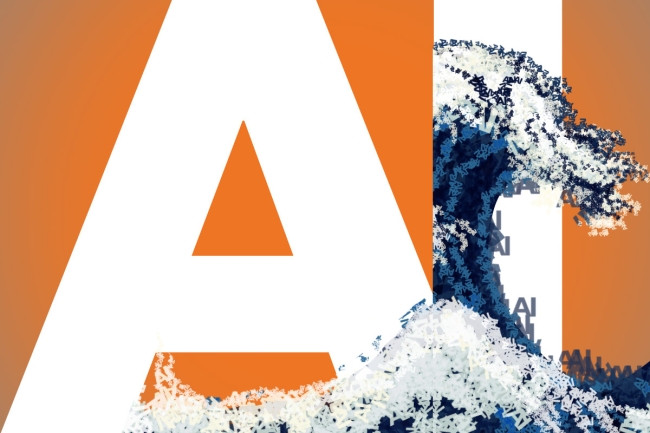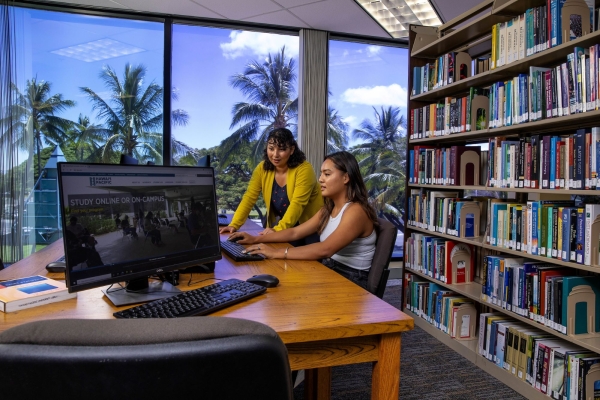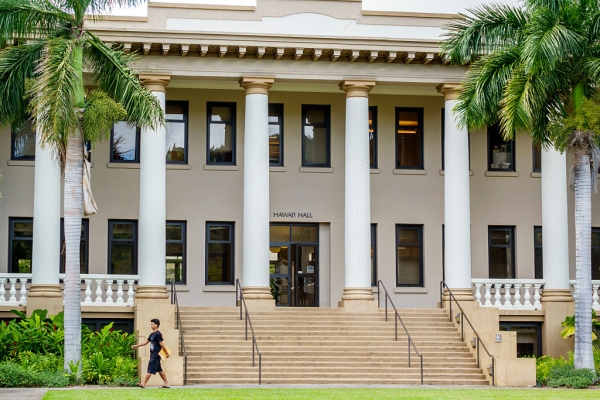You have /5 articles left.
Sign up for a free account or log in.

Hawaii wants to jump into the artificial intelligence wave - but some hurdles may make it harder compared to their mainland counterparts.
Photo Illustration/Justin Morrison
Hawaii has long drawn visitors to its remote and multicultural environment, but the factors that make it a tourist destination create hurdles as Hawaiian universities push ahead into the world of artificial intelligence.
The rise of AI has brought concerns to many institutions, including implementation, cost and ethics. But Hawaiian higher ed also must contend with a lack of tech talent, few nearby research institutions for collaboration and language barriers—both for humans and the AIs.
“We have so few people and so few industry resources, so we’ve got a lot of insight to gain,” said Lance Askildson, provost at Chaminade University of Honolulu. “But we have to make an investment in terms of getting people here and keeping them here.”
The biggest struggle, university officials say, is bringing new employees—technical or otherwise—to the islands.
“Historically, it’s always been an issue,” said Garret Yoshimi, CIO for the University of Hawai'i. “We’re not the Bay [Area], Chicago, New York, Austin—so we have to try and compete for talent without the same compensation schedules and it is a bit of a challenge to make it work.”
The high cost of living coupled with lower-than-average salaries serves as a major deterrent, along with the distance from most employees’ families.
“The challenge for any new industry in Hawaii, especially tech-heavy industries, is getting people to move to one of the most isolated, urban areas on the planet,” Askildson said.
That lack of talent means doing more with less. It’s a focus of Hawai'i Pacific University’s AI rollout, which looks at efficiency in business, including recruiting, retention and fundraising efforts.

Hawai'i Pacific University recently formed an AI task force to help the university’s efficiency.
Provided/Hawai'i Pacific University
“As far as higher education goes, a lot of institutions have to run pretty lean,” said Cody Down, chief information officer at Hawai'i Pacific University, which formed an AI task force last fall.
Language barriers for both humans and machines
Language and AI is a special challenge in Hawaii. Across the 137 Hawaiian islands, there are at least 130 languages, according to a 2016 state research analysis, with a quarter of Hawaiians speaking a language other than English at home.
For Grace Tulafono-Asi, chief information officer at American Samoa Community College, parsing through a new AI language is fraught.
“We haven’t even translated some of the technology words,” said Tulafono-Asi, who is fluent in Samoan. “The language barrier is the most difficult; the skills barrier we can work with—we can train people once we have translated training guides.”
Askildson, a linguistics professor at Chaminade, said many native Hawaiians may distrust AI’s large language models—trained on large amounts of data and text—due to a lack of cultural competency.
“There is a real suspicion and skepticism about what AI can tell us when it doesn’t understand the broader ecosystem,” he said, pointing out the impossibility of training LLMs when some native languages are not in written form.
Overcoming Hawaii’s AI hurdles
There are a growing number of initiatives across the state to address the challenges. Hawaii’s first-ever chief data officer was hired in the fall, and the state began deploying AI sensors in March to help mitigate wildfires.
The Hawai'i Center for AI, an education nonprofit focused on boosting AI literacy and access across the state, launched last month. It held two workshops in its first few weeks, with both filling up almost instantly.
“We assumed there was demand out there but didn’t know if we would find the right way to connect with that demand,” said Peter Dresslar, the center’s executive director. “We’re having a lot of traction, saying, ‘Come on in, we’ll connect AI to some part of your life.”
Hawaii—like most states—has standout universities and professors paving the way with AI and research, while others remain reluctant.
The University of Hawai'i is an R1 institution, spanning 10 campuses and an additional seven community colleges. Yoshimi classifies its AI efforts as ‘middle of the pack’ compared to the rest of the nation.

The University of Hawai'i at Mānoa campus.
Photo/Getty Images
“Some states are very ahead in terms of investments, commitments and deployments,” he said. “A bunch of us are in the middle, with research projects in play and basic policies in terms of data protection, but trying to find the best deployment efforts. It’s a difficult time to figure out what the right approach is and we want to make sure it’s not overly restrictive or burdensome.”
Having less density of institutions than in places such as California, Massachusetts and Texas creates a close-knit community that shares what resources are available.
“It’s great to put our heads together whenever we can,” Yoshimi said. “I can tell you a lot of universities have a handful of really smart people and a small number have large clusters. The benefit is taking the core of great folks, building a layer around it to help with day-to-day adoption and take the bits and pieces that make it work.”





